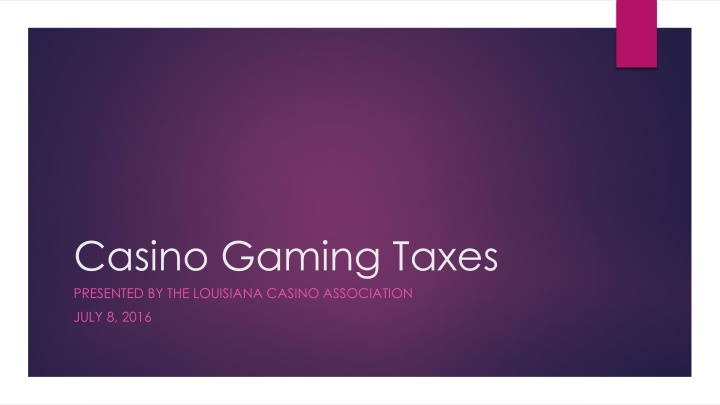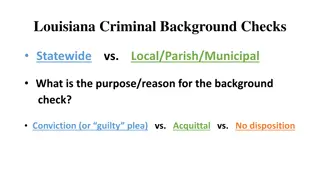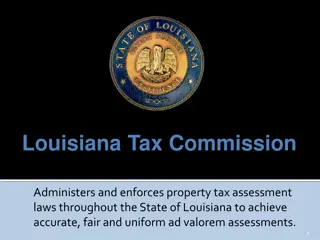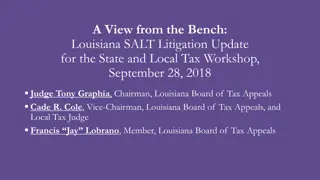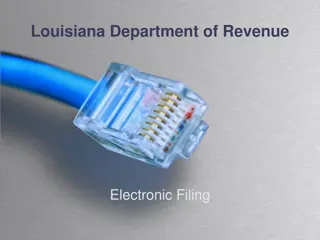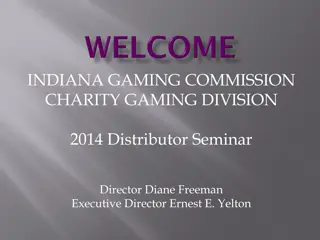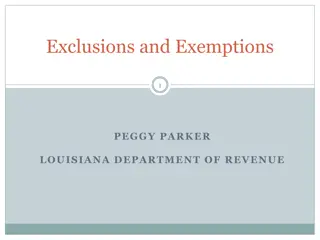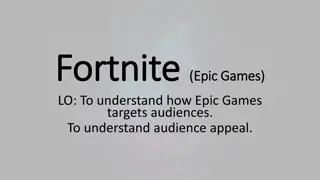Louisiana Gaming Industry Overview
Louisiana's gaming industry is regulated with limited licenses for riverboat gaming, live racing facilities, and land-based casinos. The state imposes specific tax structures, positioning itself as a major partner in the industry. Native American casinos operate separately under federal law exemptions.
Download Presentation

Please find below an Image/Link to download the presentation.
The content on the website is provided AS IS for your information and personal use only. It may not be sold, licensed, or shared on other websites without obtaining consent from the author.If you encounter any issues during the download, it is possible that the publisher has removed the file from their server.
You are allowed to download the files provided on this website for personal or commercial use, subject to the condition that they are used lawfully. All files are the property of their respective owners.
The content on the website is provided AS IS for your information and personal use only. It may not be sold, licensed, or shared on other websites without obtaining consent from the author.
E N D
Presentation Transcript
Casino Gaming Taxes PRESENTED BY THE LOUISIANA CASINO ASSOCIATION JULY 8, 2016
Industry overview Louisiana limits the number of riverboat gaming licenses to a total of fifteen which must be located on specific waterways within the state. Those fifteen licenses by market are currently distributed: Baton Rouge 3 Lake Charles 3 New Orleans Area 3 (Harvey, Kenner and Amelia) Shreveport/Bossier City 6 The total space allowed for gaming activities on each riverboat is capped at 30,000 square feet.
Industry overview - continued Louisiana limits the number of live racing facilities offering slot machine wagering to four. Those four licenses by market are currently distributed: Bossier City 1 Vinton 1 New Orleans 1 Opelousas - 1 The total space allowed for gaming activities within a racino is capped at 15,000 square feet
Industry overview - continued Louisiana limits the number of land based casinos to one. That facility is located in New Orleans. The total space allowed for gaming activities is capped at 100,000 square feet
Industry overview continued There are three Native American casinos operating in Louisiana. However these are exempt from state gaming taxes. State law does not limit their location. As these are sovereign nations state regulation of these facilities is limited and more governed by federal law State law does not limit their size
Riverboat gaming tax structure Riverboat state gaming taxes are set at 21.5% of Adjusted Gross Revenue (AGR). Total dollars in, minus winnings paid to players equals AGR Thus, the State of Louisiana is already the largest partner in the gaming industry since this tax comes off the top. All other casino expenses come after this calculation is made except for boarding fees . Local governing authorities collect on average 4.5% of AGR (depending on market) in an evolution of what began as boarding fees. This percentage is also calculated using AGR but it does not reduce the state portion. FY15 this was $73.3M
Riverboat state gaming taxes paid FY12 - $355,603,673 FY13 - $359,613,011 FY14 - $368,410,436 FY15 - $405,832,843 (15thlicense enters operation) FY16 to date - $380,847,649 Reference point in FY08 $379,241,521 were paid at the start of the national recession with 14 riverboat casinos operating. Without the 15thlicense both revenue and taxes paid would still not be back to pre-recession levels
Racino gaming tax structure Slot operations at live racing facilities (racinos) are subject to payments to supplement live racing purses at 18.0% of AGR and then a state gaming tax of 18.5% calculated after the purse supplement is made. Additionally local governments collect up to 4.0% of the post-purse payment amount but this does not diminish the payment to the state. Payments to local governments in FY15 was $10.7M.
Racino state gaming taxes and purses paid FY12 - $72,417,373 purse payment $61,031,753 state gaming tax FY13 - $72,370,285 purse payment $60,992,067 state gaming tax FY14 - $69,612,938 purse payment $58,668,237 state gaming tax FY15 - $68,409,273 purse payment $57,653,815 state gaming tax *FY16 - $57,750,389 purse payment $49,513,522 state gaming tax Reference point in FY08 $58,309,974 in state gaming taxes were paid at the start of the national recession. Revenues and taxes paid continue to hover around pre-recession levels * - FY Incomplete
Land based casino tax structure The land based operator pays the state the greater of $60,000,000 annually or 21.5% of GGR.
Land based state gaming taxes paid FY12 - $73,524,385 FY13 - $72,577,347 FY14 - $72,556,897 FY15 - $71,445,751 *FY16 - $58,910,364 Reference point in FY08 $90,239,866 were paid at the start of the national recession. Both casino revenue and state taxes paid are still not be back to pre-recession levels * - FY incomplete
State gaming tax revenues totals Gaming Format Riverboat Land Based Racinos Revenue FY15-16 $405,832,843 $ 71,445,751 $ 57,653,815 Total $534,932,409
Source: Income and Sales Tax Options: Broad Base and Low Rates Jim Richardson, Steve Sheffrin and James Alm
Gaming tax rates in other states State gaming tax rates in states with similar gaming formats Nevada 6.75% Mississippi 8.% New Jersey 8% Michigan 8.1% Indiana graduated rate from 15% to 40% Illinois graduated rate from 15% to 50% Iowa graduated rate up to 22% or 24% by format Texas 15% ??? Colorado graduated rate up to 20% Louisiana 21.5% Missouri 22%
Rankings by gaming tax revenue State Revenue - 2015 $889,130,000 $632,240,000 $608,060,000 $488,040,000 $443,890,000 $329,350,000 $311,240,000 $252,410,000 $237,090,000 $113,800,000 Number of casinos 265 20 13 10 13 18 3 30 12 41 Nevada Louisiana Indiana Illinois Missouri Iowa Michigan Mississippi New Jersey Colorado
Limitations on revenue Artificial square footage limitations some boats are already built to size Water based format restricts design and impacts customer appeal, increased construction and maintenance costs Geographic restrictions on location only certain waterways are eligible There is a practical inability to pass on increased taxes or other costs to customers Louisiana s regulatory model is 24 years old. Regulators and industry continue to work for greater efficiencies through changes in technology and process Comparatively high tax rate makes reinvestment a challenge
Competitive pressures Tax treatment of player winnings in other states higher wagering players are more mobile and aware of tax implications In-state Native American casinos Out-of-state Native American casinos Mississippi s lower state/local gaming tax rate allows for much larger and more aggressive marketing budgets which in turn drives players to MS casinos Treatment of promotional credits Mississippi does not treat such credits as gaming revenue subject to tax. This allows for their more liberal use.
Indian gaming proximity DALLAS Area: Key Market to NWLA OK Casinos Under 1 Hour Drive 68 miles - Winstar 211 Miles SHV/Bossier
Key Points The state is already the largest beneficiary or economic partner of revenue from gaming due to state gaming taxes being calculated on gross revenue. The gaming industry pays state & local gaming taxes and these are in addition to every other tax paid by businesses in Louisiana Tax increases in other areas also affect gaming i.e., sales taxes, tobacco, alcohol Gaming taxes (including video poker) are the fourth largest source of state generated revenue, $713.4M FY2015 or approximately 8% of the state s current budget estimate. Unlike retail or manufacturing there is no practical means to offset increases in gaming taxes by passing increased costs on to the consumer Though slowly improving, casino revenues and therefore state gaming tax receipts have not yet returned to pre-recession levels when examined property by property.
